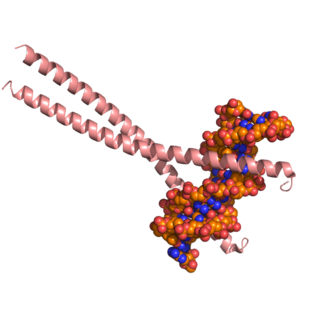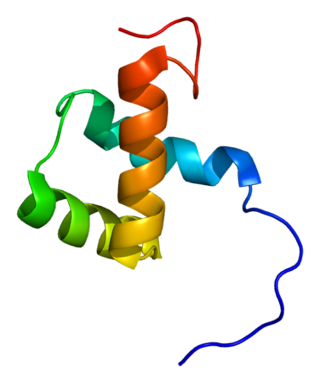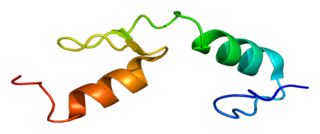Zinc finger protein 148 is a protein that in humans is encoded by the ZNF148 gene. [4] [5] [6]
Zinc finger protein 148 is a protein that in humans is encoded by the ZNF148 gene. [4] [5] [6]
ZNF148 has been shown to interact with PTRF [7] and P53. [8]

Transcription factor Sp1, also known as specificity protein 1* is a protein that in humans is encoded by the SP1 gene.
In molecular genetics, the Krüppel-like family of transcription factors (KLFs) are a set of eukaryotic C2H2 zinc finger DNA-binding proteins that regulate gene expression. This family has been expanded to also include the Sp transcription factor and related proteins, forming the Sp/KLF family.

CCAAT/enhancer-binding protein beta is a protein that in humans is encoded by the CEBPB gene.

CAMP responsive element binding protein 1, also known as CREB-1, is a protein that in humans is encoded by the CREB1 gene. This protein binds the cAMP response element, a DNA nucleotide sequence present in many viral and cellular promoters. The binding of CREB1 stimulates transcription.

Tripartite motif-containing 28 (TRIM28), also known as transcriptional intermediary factor 1β (TIF1β) and KAP1, is a protein that in humans is encoded by the TRIM28 gene.

Methyl-CpG-binding domain protein 2 is a protein that in humans is encoded by the MBD2 gene.

Y box binding protein 1 also known as Y-box transcription factor or nuclease-sensitive element-binding protein 1 is a protein that in humans is encoded by the YBX1 gene.

YY1 is a transcriptional repressor protein in humans that is encoded by the YY1 gene.

Zinc finger E-box-binding homeobox 1 is a protein that in humans is encoded by the ZEB1 gene.

MHC class II regulatory factor RFX1 is a protein that, in humans, is encoded by the RFX1 gene located on the short arm of chromosome 19.

Transcriptional regulator Kaiso is a protein that in humans is encoded by the ZBTB33 gene. This gene encodes a transcriptional regulator with bimodal DNA-binding specificity, which binds to methylated CGCG and also to the non-methylated consensus KAISO-binding site TCCTGCNA. The protein contains an N-terminal POZ/BTB domain and 3 C-terminal zinc finger motifs. It recruits the N-CoR repressor complex to promote histone deacetylation and the formation of repressive chromatin structures in target gene promoters. It may contribute to the repression of target genes of the Wnt signaling pathway, and may also activate transcription of a subset of target genes by the recruitment of catenin delta-2 (CTNND2). Its interaction with catenin delta-1 (CTNND1) inhibits binding to both methylated and non-methylated DNA. It also interacts directly with the nuclear import receptor Importin-α2, which may mediate nuclear import of this protein. Alternatively spliced transcript variants encoding the same protein have been identified.

C-terminal-binding protein 2 also known as CtBP2 is a protein that in humans is encoded by the CTBP2 gene.

Zinc finger protein Gfi-1 is a transcriptional repressor that in humans is encoded by the GFI1 gene. It is important normal hematopoiesis.

Zinc finger protein 40 is a protein that in humans is encoded by the HIVEP1 gene.

Krueppel-like factor 12 is a protein that in humans is encoded by the KLF12 gene.

Zinc finger protein 350 is a protein that in humans is encoded by the ZNF350 gene.

DNA-binding protein RFX2 is a protein that in humans is encoded by the RFX2 gene.

Ras-responsive element-binding protein 1 is a protein that in humans is encoded by the RREB1 gene.

Polymerase I and transcript release factor, also known as Cavin1, Cavin-1 or PTRF, is a protein which in humans is encoded by the PTRF gene.

Krüppel-like factor 3 is a protein that in humans is encoded by the KLF3 gene.
This article incorporates text from the United States National Library of Medicine, which is in the public domain.